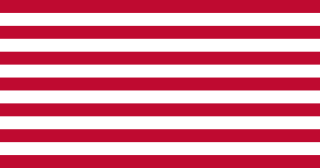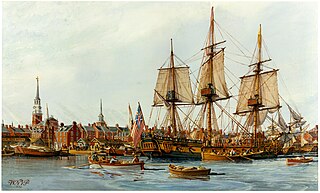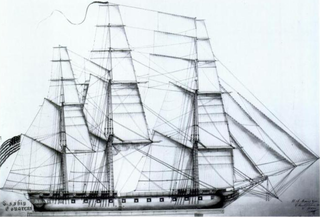
USS United States was a wooden-hulled, three-masted heavy frigate of the United States Navy and the first of the six original frigates authorized for construction by the Naval Act of 1794. The name "United States" was among ten names submitted to President George Washington by Secretary of War Timothy Pickering in March of 1795 for the frigates that were to be constructed. Joshua Humphreys designed the frigates to be the young Navy's capital ships, and so United States and her sisters were larger and more heavily armed and built than standard frigates of the period. She was built at Humphrey's shipyard in Philadelphia, Pennsylvania and launched on 10 May 1797 and immediately began duties with the newly formed United States Navy protecting American merchant shipping during the Quasi-War with France.

The first Alliance of the United States Navy was a 36-gun sailing frigate of the American Revolutionary War.
The continental Navy frigate USS Deane was originally a ship secretly ordered by the American Commissioners from the Nantes shipowner Jean Peltier Dudoyer.

The Continental Navy was the navy of the Thirteen Colonies during the American Revolutionary War. Founded on October 13, 1775, the fleet developed into a relatively substantial force throughout the Revolutionary War, owing partially to the substantial efforts of the Continental Navy's patrons within the Continental Congress. These Congressional Patrons included the likes of John Adams, who served as the Chairman of the Naval Committee until 1776, when Commodore Esek Hopkins received instruction from the Continental Congress to assume command of the force.
USS Delaware was a 24-gun sailing frigate of the United States Navy that had a short career in the American Revolutionary War as the British Royal Navy captured her in 1777. The Royal Navy took her in as an "armed ship", and later classed her a sixth rate. The Royal Navy sold her in 1783. British owners named her United States and then French interests purchased her and named her Dauphin. She spent some years as a whaler and then in March 1795 she was converted at Charleston, South Carolina, to French privateer. Her subsequent fate is unclear.

USS Ranger was a sloop-of-war in the Continental Navy, serving from 1777–1780 and the first to bear her name. Built at Portsmouth Naval Shipyard on Badger's Island in Kittery, Maine, she is famed for the solo raiding campaign carried out by her first captain, John Paul Jones, during naval operations of the American Revolutionary War. In six months spent primarily in British waters, she captured five prizes, staged a single failed attack on the English mainland at Whitehaven, and caused Royal Navy ships to be dispatched against her in the Irish Sea.

Alfred was the merchant vessel Black Prince, named for Edward, the Black Prince, and launched in 1774. The Continental Navy of what would become the United States Navy acquired her in 1775, renamed her Alfred after 9th century English monarch Alfred the Great, and commissioned her as a warship. She participated in two major actions, the battle of Nassau, and the action of 6 April 1776. The Royal Navy captured her in 1778, took her into service as HMS Alfred, and sold her in 1782. She then became the merchantman Alfred, and sailed between London and Jamaica.

USS Raleigh was one of thirteen ships that the Continental Congress authorized for the Continental Navy in 1775. Following her capture in 1778, she served in the Royal Navy as HMS Raleigh. The ship is featured on the flag and seal of New Hampshire.
John Peck Rathbun (1746–1782) was an officer in the Continental Navy and in the United States Navy. Rathbun was from Rhode Island with family in Boston. Rathbun served in the Continental Navy from its late 1775 beginning as John Paul Jones First Lieutenant.

The second Hancock was one of the first thirteen frigates of the Continental Navy. A resolution of the Continental Congress dated 13 December 1775 authorized her construction; she was named for the patriot and Continental congressman John Hancock. In her career, she served under the American, British and French flags.

HMS Drake was a Royal Navy 14-gun ship rigged sloop-of-war with a displacement of 275 tons burthen. Originally named the Royal Oak, she was built in New England in 1775 by John Wharton from Philadelphia. She first sailed between London and Stettin as a tobacco-ship. She was then sold in 1776 and renamed Resolution. Captained by Edward Hawker, the ship traded between London, Boston, and Cork. On 4 March 1777 the British navy purchased her at Plymouth for 3,000 pounds sterling. She completed fitting out as a warship on 24 May 1777. She became the ship-rigged sloop-of-war Drake with either 14, 18 or 20 guns. From July 17, 1777, she served in the American Revolutionary War. Her first mission was protecting the packet-boats between Harwich and Gorée

The Foudroyant was an 80-gun ship of the line of the French Navy. She was later captured and served in the Royal Navy as the Third Rate HMS Foudroyant.
HMS Ariel was a 20-gun Sphinx-class sixth-rate post ship of the Royal Navy. The French captured her in 1779, and she served during the American Revolutionary War for them, and later for the Americans, before reverting to French control. Her French crew scuttled Ariel in 1793 to prevent the British from recapturing her.

Badger's Island is located in the Piscataqua River at Kittery, Maine, United States, directly opposite Portsmouth, New Hampshire. It carries U.S. Route 1 between the states, connecting to the Kittery mainland by the Badger's Island Bridge, and to New Hampshire by the Memorial Bridge. Now largely a suburb of Portsmouth, the island features houses, condominiums, restaurants and marinas.

The Roebuck-class ship was a class of twenty 44-gun sailing two-decker warships of the Royal Navy. The class carried two complete decks of guns, a lower battery of 18-pounders and an upper battery of 9-pounders. This battery enabled the vessel to deliver a broadside of 285 pounds. Most were constructed for service during the American Revolutionary War but continued to serve thereafter. By 1793 five were still on the active list. Ten were hospital ships, troopships or storeships. As troopships or storeships they had the guns on their lower deck removed. Many of the vessels in the class survived to take part in the Napoleonic Wars. In all, maritime incidents claimed five ships in the class and war claimed three.

The Third Battle of Ushant or the action of 20–21 April 1782 was a naval battle fought during the American Revolutionary War, between a French naval fleet of three ships of the line protecting a convoy and two British Royal naval ships of the line off Ushant, a French island at the mouth of the English Channel off the northwesternmost point of France. This was the third battle that occurred in this region during the course of the war.

James Hackett (1739–1802) was an American shipbuilder in New Hampshire in the late 18th century. He was responsible for the construction of a number of significant Revolutionary War-era warships for the fledgling country, including the Raleigh, Ranger, America, Congress, Portsmouth, two cutters for the United States Revenue Cutter Service, as well as the Crescent, built for Algiers as tribute. As a teenager, he served with Rogers' Rangers during the French and Indian War. His later military service included serving as lieutenant colonel in the New Hampshire Militia during the Revolutionary War and after in several different units.

HMS Ceres was an 18-gun sloop launched in 1777 for the British Royal Navy that the French captured in December 1778 off Saint Lucia. The French Navy took her into service as Cérès. The British recaptured her in 1782 and renamed her HMS Raven, only to have the French recapture her again early in 1783. The French returned her name to Cérès, and she then served in the French Navy until sold at Brest in 1791.

HMS Roebuck was a fifth-rate ship of the Royal Navy which served in the American and French Revolutionary Wars. Designed in 1769 by Sir Thomas Slade to operate in the shallower waters of North America, she joined Lord Howe's squadron towards the end of 1775 and took part in operations against New York the following year. She engaged the American gun batteries at Red Hook during the Battle of Long Island in August 1776, and forced a passage up the Hudson River in October. On 25 August 1777, Roebuck escorted troopships to Turkey Point, Maryland, where an army was landed for an assault on Philadelphia. She was again called upon to accompany troopships in December 1779, this time for an attack on Charleston. When the ships-of-the-line, which were too large to enter the harbour, were sent back to New York, Admiral Marriot Arbuthnot made Roebuck his flagship. She was, therefore, at the front of the attack, leading the British squadron across the shoal to engage Fort Moultrie and the American ships beyond.

HMS Amazon was a 32-gun fifth-rate frigate of the Royal Navy, armed with a main battery of twenty-six 12 pounders and launched at Rotherhithe shipyard in 1773. She was first commissioned in February 1776 for war in America where she took part in operations against New York. Returning to England in February 1779, Amazon underwent a refit before serving in the English Channel and North Sea. In April 1780, she sailed to the Leeward Islands where, in October, she was almost wrecked in a hurricane.















